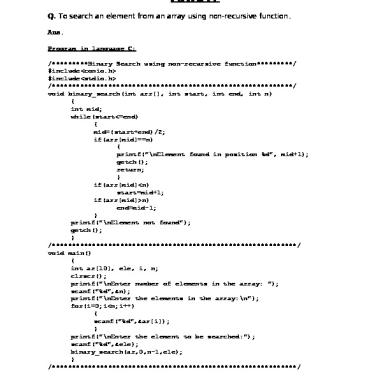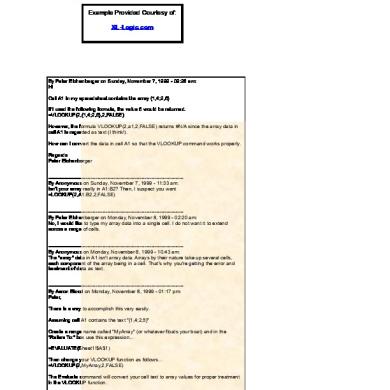Matrix Equipmets Using Orthogonal Array
This document was uploaded by user and they confirmed that they have the permission to share it. If you are author or own the copyright of this book, please report to us by using this DMCA report form. Report DMCA
Overview
Download & View Matrix Equipmets Using Orthogonal Array as PDF for free.
More details
- Words: 540
- Pages: 2
16.881 – Robust System Design
Homework #4
Matrix Experiments Using Orthogonal Arrays
Due Date: Wednesday, June 17, 3:05, 4-149 Objectives: • Reinforce material from Phadke chapter 3 with a practical exercise and place the material in the context of the system development process • Encourage thinking about the relative importance of a few key factors in optimization by empirical methods Assignment 1. (90%) Form teams of four engineers to consider the parameter design of a paper helicopter. Your task is to design a helicopter that can transport a payload from seven feet above the ground (as measured from the bottom of the helicopter) to the ground in two seconds. Your company designs, manufactures, and operates these helicopters. Your company has contracted with a customer who will buy 100 “rides” in your helicopter over the life of the contract. For a time of exactly two seconds, they will pay you $100, but they have specified a tolerance of ±0.3 seconds and will reduce their payment according to a nominal-the best quality loss function. The difficulty is that the customer will vary the payload between one and two passengers (paper clips) and they want a single design to do both tasks with no adjustments. In practice, we will estimate the average loss for your design using a run of six flight tests, three at each payload level. This test will be conducted at 2:45 under the supervision of “the customer”. Each prototype helicopter you manufacture costs $10 and every test of a helicopter costs $2. Each helicopter must be made from a single piece of 8.5”X11” paper. You can decide where the paper clips attach to your design, but cannot deform them plastically. Your job as an engineer is to maximize the profits on this contract. The team with the highest profit will have 10 points added to their grade on this homework.
(Pr. 1 cont.)
You will write a report on your efforts of no more than ten pages including figures.
Some ideas on what to include in such a report are:
• Your engineering and economic strategy • The engineering considerations that drove your parametric design (did you model the design at any level?) • Your experimental strategy • The difficulties of conducting the experiment • An analysis of the data • A summary of your engineering and economic performance
2. (10%) Comment on the relative efficiency of an L8 (27) matrix experiment as compared to a single factor at a time approach to an experiment with the same number of control factors and levels. You may wish to experiment with the Mathcad sheet “efficiency4.mcd” available on the course web site. Speciffically address the following questions: a) What is the ratio of the variance in a control factor effect as estimated with an L8 as compared to the variance as estimated with a one-factor at a time experiment (all other things being equal)? By “variance in control factor effects” I mean variation in the estimated control factor effect upon repeated trials of the matrix experiment. b) How does the difference between levels for a single factor (that is, how far apart you, the designer, set the levels) affect the variance in a control factor effect as estimated with an L8?
Homework #4
Matrix Experiments Using Orthogonal Arrays
Due Date: Wednesday, June 17, 3:05, 4-149 Objectives: • Reinforce material from Phadke chapter 3 with a practical exercise and place the material in the context of the system development process • Encourage thinking about the relative importance of a few key factors in optimization by empirical methods Assignment 1. (90%) Form teams of four engineers to consider the parameter design of a paper helicopter. Your task is to design a helicopter that can transport a payload from seven feet above the ground (as measured from the bottom of the helicopter) to the ground in two seconds. Your company designs, manufactures, and operates these helicopters. Your company has contracted with a customer who will buy 100 “rides” in your helicopter over the life of the contract. For a time of exactly two seconds, they will pay you $100, but they have specified a tolerance of ±0.3 seconds and will reduce their payment according to a nominal-the best quality loss function. The difficulty is that the customer will vary the payload between one and two passengers (paper clips) and they want a single design to do both tasks with no adjustments. In practice, we will estimate the average loss for your design using a run of six flight tests, three at each payload level. This test will be conducted at 2:45 under the supervision of “the customer”. Each prototype helicopter you manufacture costs $10 and every test of a helicopter costs $2. Each helicopter must be made from a single piece of 8.5”X11” paper. You can decide where the paper clips attach to your design, but cannot deform them plastically. Your job as an engineer is to maximize the profits on this contract. The team with the highest profit will have 10 points added to their grade on this homework.
(Pr. 1 cont.)
You will write a report on your efforts of no more than ten pages including figures.
Some ideas on what to include in such a report are:
• Your engineering and economic strategy • The engineering considerations that drove your parametric design (did you model the design at any level?) • Your experimental strategy • The difficulties of conducting the experiment • An analysis of the data • A summary of your engineering and economic performance
2. (10%) Comment on the relative efficiency of an L8 (27) matrix experiment as compared to a single factor at a time approach to an experiment with the same number of control factors and levels. You may wish to experiment with the Mathcad sheet “efficiency4.mcd” available on the course web site. Speciffically address the following questions: a) What is the ratio of the variance in a control factor effect as estimated with an L8 as compared to the variance as estimated with a one-factor at a time experiment (all other things being equal)? By “variance in control factor effects” I mean variation in the estimated control factor effect upon repeated trials of the matrix experiment. b) How does the difference between levels for a single factor (that is, how far apart you, the designer, set the levels) affect the variance in a control factor effect as estimated with an L8?
Related Documents

Matrix Equipmets Using Orthogonal Array
November 2019 4
Orthogonal Array Testing
November 2019 9
Stacks Using Array
May 2020 1
Array
June 2020 19
Array
November 2019 29